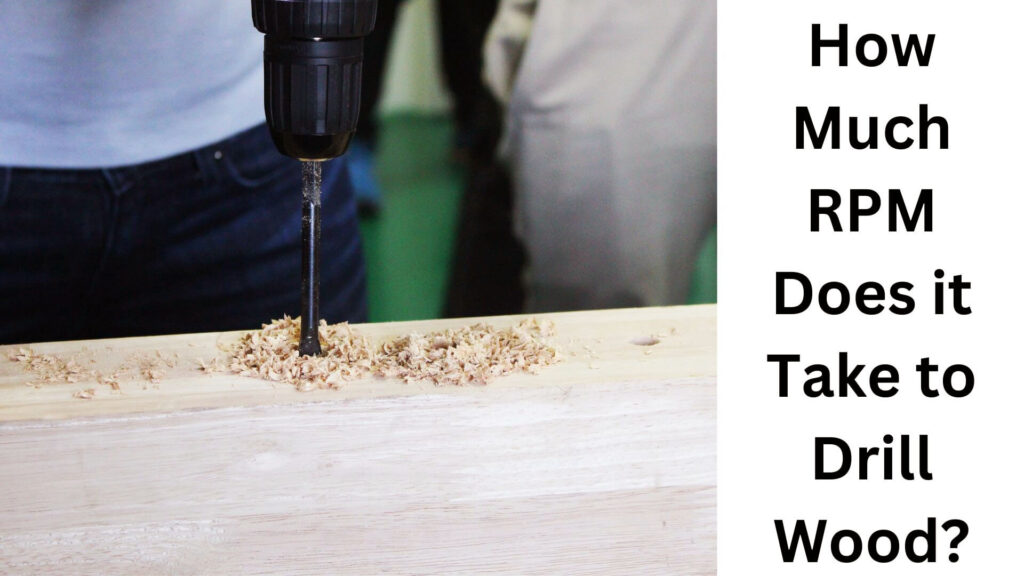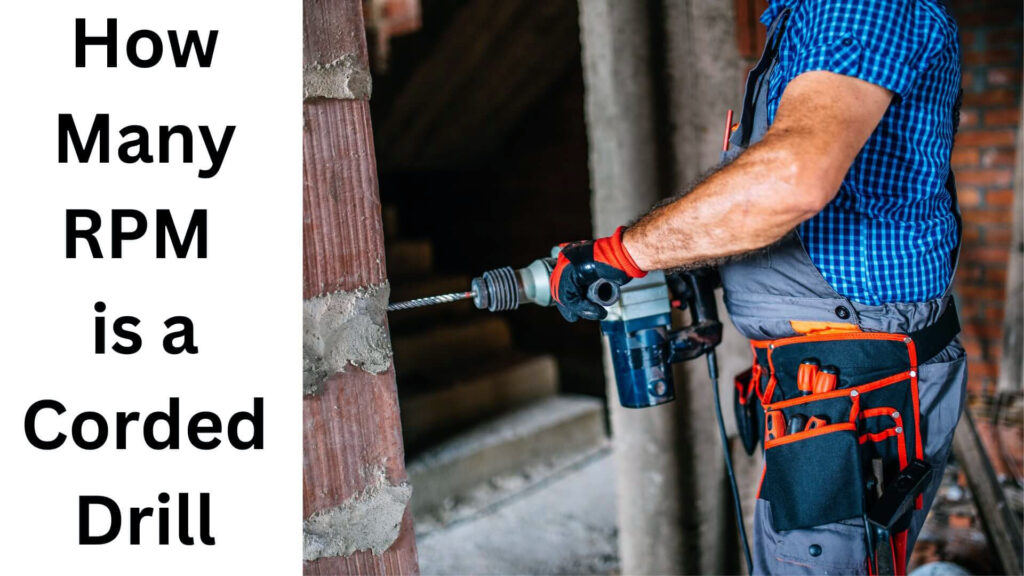Corded drills are a go-to tool for both professionals and DIY enthusiasts due to their reliability and power. One of the key specifications that users look at when selecting a corded drill is its revolutions per minute (RPM). RPM plays a crucial role in determining how fast and efficiently a drill operates for various tasks. In this post, we’ll explore everything you need to know about RPM in corded drills, how it compares to cordless drills, and how to choose the best drill based on your RPM requirements.
Table of Contents
What is rpm in a drill?
RPM, or revolutions per minute, is the number of times a drill’s chuck rotates in one minute. In simpler terms, it’s a measurement of how fast the drill bit spins. The higher the RPM, the faster the drill bit will rotate, allowing you to drill into materials more quickly.
RPM is crucial because it affects both the speed and precision of drilling. High RPM is ideal for drilling into softer materials like wood, while lower RPM is necessary for harder materials like metal and masonry to prevent overheating and damage to both the drill bit and the material.
Does rpm matter for a drill?
Yes, RPM absolutely matters when it comes to choosing and using a drill. The RPM determines how well your drill will perform in different scenarios:
- High RPM: Best for drilling into softer materials such as wood and plastic. It allows for faster drilling with smoother holes.
- Low RPM with High Torque: Necessary for drilling into harder materials like metal, concrete, or masonry. Lower speeds prevent the drill bit from overheating, ensuring precise cuts without damaging the material or the drill bit.
The key is to match the RPM of the drill to the type of material you’re working with. Most drills come with variable speed settings, allowing you to adjust the RPM based on the task at hand.
How many rpm is a corded drill?
Corded drills generally have higher RPMs compared to their cordless counterparts. The RPM of a corded drill typically ranges from 1,500 to 3,000 RPM. High-end corded drills can have variable speed controls, allowing users to adjust the RPM depending on the task.
A basic corded drill will often offer a single speed of around 2,000 RPM, while more advanced models may offer variable speeds ranging from 500 RPM to 3,000 RPM, giving you the flexibility to switch between different materials like wood, metal, and masonry.
Check Also: Awesome Corded Drills Reviewed by Experts.
What is the rpm of a cordless drill?
Cordless drills generally have lower RPMs compared to corded drills due to their reliance on battery power. A standard cordless drill can range between 500 and 2,000 RPM. The lower RPM in cordless drills is a result of the trade-off for portability and convenience.
While some high-end cordless drills offer variable speed options similar to corded drills, they might not reach the same maximum RPM levels, making them less suitable for heavy-duty tasks.
Read More: How Many Amps Does a Corded Drill Use
How many rpm is a Dewalt drill?
DeWalt is a leading manufacturer of power tools, and its corded drills typically offer high RPMs. A standard DeWalt corded drill will offer speeds between 1,000 to 2,500 RPM. Many DeWalt drills come with variable speed settings, which allow users to adjust the RPM based on the task. For instance, the DeWalt DWD112 offers 0-2,500 RPM, making it ideal for a range of materials, from wood to metal.
How many rpm is a Makita drill?
Makita is another top brand known for its reliable power tools. The RPM of a Makita corded drill can range from 1,200 to 2,800 RPM, depending on the model. Makita’s corded drills are known for their powerful motors and variable speed control, which allows users to fine-tune the RPM for different applications.
For example, the Makita HP2050F offers variable speeds from 0 to 2,900 RPM, providing flexibility for both light and heavy-duty tasks.
How many rpm is a hammer drill?
Hammer drills are designed for heavy-duty tasks like drilling into masonry, concrete, and stone. Due to the added hammering action, the RPM of a hammer drill is usually lower than that of a standard drill. A typical hammer drill operates at 0 to 1,500 RPM. The lower RPM is compensated by the hammering action, which allows the drill to break through hard materials more effectively.
Many hammer drills also come with variable speed settings, so users can adjust the RPM for different materials.
Check Also: 8 Awesome Corded Drills for Wood Workers.
How many rpm does it take to drill wood?

Wood is a softer material, so drilling into it typically requires higher RPMs for a smooth, clean cut. For wood drilling, an RPM between 1,500 and 3,000 RPM is generally recommended. The higher RPM helps the drill bit penetrate the wood quickly without causing splinters or rough edges.
For softer woods, you can use RPMs closer to the higher end of the spectrum (around 3,000 RPM), while for hardwoods, you may want to dial it down to prevent overheating.
Read More: How To Drill A Hole In Wood Easily & Safely Without A Drill?
How many rpm does it take to drill concrete?

Concrete is a hard, dense material, so drilling into it requires lower RPMs but with higher torque. For drilling into concrete, the RPM should be between 500 and 1,500 RPM, depending on the drill bit and the thickness of the concrete.
Hammer drills or rotary hammers are typically used for concrete drilling due to their lower RPMs combined with their hammering action, which helps break through the concrete effectively.
Read More: Are Corded Drills More Powerful?
What is the difference between a corded and an electric drill?
The terms “corded” and “electric” are often used interchangeably, but there’s a distinction:
- Corded Drill: A drill that is powered by being plugged into an electrical outlet. It offers continuous power and higher RPM, making it ideal for heavy-duty tasks.
- Cordless Drill (Electric): A battery-powered drill that offers the convenience of portability. However, it generally has a lower RPM compared to corded drills, making it better suited for lighter tasks or areas without access to power outlets.
In summary, corded drills are known for higher power and RPM, while cordless drills offer flexibility and convenience.
Read More: Using Corded Drills Like a Pro.
Which type of corded drill is best for me?
Choosing the best corded drill depends on the tasks you plan to undertake. Here are a few factors to consider:
Type of Material: If you’re drilling into harder materials like metal or concrete, choose a drill with lower RPM and higher torque. For softer materials like wood, a higher RPM drill will work best.
Power and RPM: If you need a drill for heavy-duty work such as drilling into masonry or metal, opt for a corded drill with high power and variable RPM settings. Drills with 2,000 to 3,000 RPM are ideal for versatile use.
Size and Weight: Corded drills are generally lighter than cordless ones since they don’t have a battery. Choose a model that feels comfortable and balanced in your hand.
Price: Corded drills are usually more affordable than cordless ones because they don’t require expensive battery systems. However, premium models with higher power and advanced features can still be costly.
Check Also: Can you Use a Corded Drill as a Screwdriver?
Frequently Asked Questions.
How do you know how many rpm a corded drill is?
The RPM of a corded drill is usually listed on the manufacturer’s label or in the user manual. If you can’t find this information, you can also look it up online based on the make and model of your drill.
How fast can a corded drill?
Most corded drills operate at speeds between 500 and 3,000 RPM. The speed can vary depending on the model and the type of task it’s designed for.
How fast can a corded drill?
Cordless drills usually have lower RPM compared to corded drills, ranging from 500 to 2,000 RPM. This is because cordless drills are powered by batteries, which limits their speed and torque.
How long does a corded drill take to charge?
Corded drills don’t need to charge since they are powered by electricity from an outlet. This is one of the major advantages of using a corded drill over a cordless one.
How do you change the battery on a cordless drill?
To change the battery on a cordless drill, simply press the release button or lever located near the base of the drill handle, slide out the old battery, and insert a fully charged one.
Conclusion
Understanding the RPM of a corded drill is essential for selecting the right tool for your projects. The RPM determines how fast and efficiently a drill bit will spin, and knowing the correct speed for different materials can significantly impact the quality of your work. Corded drills typically offer higher RPMs than cordless drills, making them ideal for tasks that require more power and endurance.
When selecting a corded drill, consider the materials you’ll be working with, the power and speed settings, and whether you need a variable-speed option. With the right drill, you’ll be able to tackle any task with confidence and precision.
By keeping these factors in mind and maintaining your drill properly, you can ensure a long-lasting and efficient tool that will serve you well for years to come.

Hey, I am MD Hrithik Hossain, I’m a huge fan of DIY crafts. My workshop is where I spend most of my spare time, and I’m always working on some project. To that end, I’d like to share some of my knowledge and experience with you in power tools, woodworking, and other specialized materials fabrication.
I will guide you with genuine knowledge that can assist you with deciding whether a drill is appropriate according to your requirements or not. If you want to find the best drill and know which type of drill is most suited for your needs, then I can guide you with my expertise. My passion lies in helping others find the correct products they need at an affordable price.


